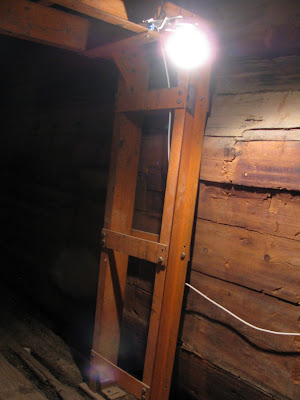Surrounding the town of Gordion (and the citadel I showed in the last post), are more than a hundred tumuli - burial mounds built by the Phrygians during various periods. The largest and most famous of these is the Midas tomb. There is a large wooden structure that forms the tomb, over which was piled a thick layer of gravel, and then the mound was built over the entire thing. They originally thought it might be the tomb of King Midas, but dendrochronology (tree ring dating) has confirmed that it is slightly too old to be him, and might in fact be the tomb of Midas' father. Either way, its very impressive, in size, construction, and in the amazing array of artifacts they found inside. It took a team of Turkish miners hauling out material to get to the tomb itself, and a lot of engineering know-how to successfully excavate it without the entire thing collapsing.
This is the entrance to the mound, and follows the path cut into the mound for the mining cars when it was excavated. I don't think this picture really does justice to the scale of it, but I tried.
The outside of the wooden tomb, with steel supports to hold the beams in place. Originally the gravel fill surrounding the beams would have kept them in place. Tourists aren't allowed into this area, but we got a special tour. We might even get to clean some of the tomb!
Inside the tomb, with supports that keep the inner walls from cracking and collapsing.
A corner workspace just outside the tomb.
These devices are attached to many of the beams, and monitor the movement of the wood as the logs expand and contract. In theory, if the tomb was in danger of imminent collapse, these would let them know.






No comments:
Post a Comment